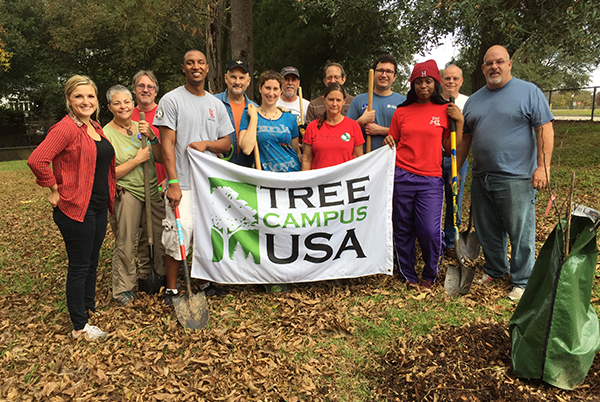The University of Louisiana at Lafayette is the first, and only, higher education institution in the state to earn the “Green Ribbon School” designation from the Louisiana Department of Wildlife and Fisheries.
The designation recognizes schools, from elementary to postsecondary, and school districts, for comprehensive, campus- or district-wide sustainability practices and programs. UL Lafayette is among five schools in Louisiana that were recently named Green Ribbon Schools.
Gretchen Vanicor, director of UL Lafayette’s Office of Sustainability, said a campus sustainability policy was implemented in 2014. But the University’s sustainability and conservation practices can be traced to the University’s roots, when its first president, Dr. Edwin L. Stephens, hand-planted live oak trees on campus.
“Recognition as a Green Ribbon School is indicative of the University’s ongoing, decades long commitment to sustainability, which encompasses everything from recycling efforts to student research projects,” Vanicor explained.
Schools or school districts earn Green Ribbon School status by making strides in three key areas:
- reducing environmental impact and costs;
- improving health and wellness of students and staff; and
- providing effective sustainability education.
States are allowed to nominate five K-12 schools or districts, and one college or university, each year. Nominations are submitted to the U.S. Department of Education.
Brian Gautreau is Green Schools coordinator with the Louisiana Department of Wildlife and Fisheries. He cited a range of UL Lafayette programs and initiatives, from LEED certification for the Student Union, to student volunteer efforts and STEM research.
Renovation and expansion of the Student Union was completed last year. The building earned a silver rating as part of the U.S. Green Building Council’s Leadership in Energy and Environmental Design program. LEED recognition is based on several factors, including types of materials used in construction, efficient energy use, and recycling.
More than 77 percent of debris generated during demolition of the original Student Union was recycled. The recycled material amounted to more than 440 tons of metal and 11,504 tons of concrete.
Gautreau also mentioned the University’s Zero Waste programs, which include the Geaux RED initiative, and the GameDay Recycling Challenge.
Zero Waste focuses on reducing the amount of material that ends up in a landfill. Collection bags for paper, plastic cardboard and aluminum are available in all administrative buildings and faculty offices. There are also receptacles for recyclable materials across campus.
Geaux RED, or Recycle Everything Daily, fosters recycling efforts with the placement of bins in campus offices and outdoors. New bins were recently added in the lobbies of each academic college.
“Recycling has been expanded into public spaces of 10 major buildings, the Quadrangle, and other outdoor areas on campus,” Vanicor said.
The GameDay Recycling Challenge, a national collegiate recycling contest, encourages universities to measure the amount of recyclable materials collected during home football games. The program was instituted in 2014. That year, the University was ranked 10th in the nation for its diversion rate, which is the percentage of waste that is redirected from landfills to recycling facilities.
Since the program began, the diversion rate during home football games has more than doubled, from almost 29 percent to 59 percent, according to Vanicor.
Overall, the University’s diversion rate has increased from 3 percent 41 percent in a span of two years.
Students are contributing to campus and community sustainability efforts. During six University-organized clean-ups in 2015, 1,438 students pitched in 5,713 hours of work, and filled 707, 13-gallon trash bags with litter from roadsides and public spaces.
Gautreau singled out student volunteer efforts, such as coastal restoration projects coordinated through AmeriCorps, a national community service program. UL Lafayette’s program is the only university-based AmeriCorps program in Louisiana.
He also commended the University’s sustainability-driven research opportunities for students, including at the Cleco Alternative Energy Center in Crowley, La. Researchers there are evaluating technical and economic aspects of producing electricity from sustainable materials, rather than fossil fuels. Energy sources include everything from sunlight, captured by large solar panels, to alligator fat, which is converted to biofuel.
The center is also a learning environment for students. They participate in research and testing for projects that include the production of methane using Louisiana food industry wastes, and converting agricultural waste, such as sugar cane bagasse or rice hulls, into energy.
“UL Lafayette is doing so many good things, in so many areas, to offer opportunities for hands-on sustainability learning, and to improve its sustainability footprint,” Gautreau said.
Last year, the League of American Bicyclists recognized the University as a bike friendly campus. The nonprofit organization advocates bicycling and safety for cyclists.
In 2014, the University installed new bike lanes on St. Mary Boulevard, between Taft and St. Landry streets, to increase cyclist safety and manage traffic flow. The project was a joint effort between UL Lafayette and Lafayette Consolidated Government.
The University has also added more bike racks, shelters and lockers, bringing the total number of bicycle parking spaces on campus to more than 2,700.
UL Lafayette has adopted several bike-friendly measures, such as hosting free bike maintenance workshops, and allowing students who live in residence halls to take their bicycles inside their rooms for safekeeping, Vanicor said.
The University recently launched the Geaux Vélo bike share program. A total of 52 bikes are available at three stations on campus: 32 at Cajun Field, 10 outside the Student Union on Boucher Street, and 10 inside the Girard Park Circle parking garage.
UL Lafayette also collaborated with Lafayette Consolidated Government last year to install traps on storm drains to prevent litter and organic debris from entering water drainage systems as part of a pilot project that will be expanded this year.
The U.S. Department of Education will officially announce this year’s Green Ribbon School recipients on Earth Day, which is April 22.
Learn more about the program at http://www.wlf.louisiana.gov/green-schools and http://www2.ed.gov/programs/green-ribbon-schools/index.html
Learn more about UL Lafayette sustainability and recycling at sustainability.louisiana.edu/
